IASbaba's Daily Current Affairs Analysis
Archives
(PRELIMS & MAINS Focus)
Open in new window
Syllabus
- Prelims – Environment
Context: An indigenous community called Malampadandram tribe collective is helping the authorities keep the forest roads clean at Sabarimala forests.
About Malampadandram Tribe:
- This is the name of a small, nomadic community living in the remote forest.
- Fishing and collecting fruits and other edibles from the forest are the main occupations of this community that depends on the forest for all their needs.
- The Malai Pandaram or otherwise termed as Hill Pandaram is a scheduled tribe.
- They are mainly distributed in the high range areas of Kollam and Pathanamthitta Districts. The 2011 Census recorded their population as 2,422.
- In the Travancore region they have a patios referred by others as Pandaram Basha. With others they converse in Malayalam and educated use the Malayalam script for writing.
- The major traditional occupation is hunting and gathering.
- They continue to be engaged in their traditional occupation of making and selling of rudrakshamala, tulasimala, glass beads necklace and bangles.
- Some of them have traditional knowledge in herbal medicines.
- The medicinal herbs are collected from forests of Sabarimalai, Irali (Idukki) and Wayanad.
Source: The Hindu
Previous Year Question
Q.1) With reference to India the terms ‘Halbi, ho and Kui’ pertain to (2021)
- Dance forms of Northwest India
- Musical instruments
- Pre-historic cave paintings
- Tribal languages
Open in new window
Syllabus
- Prelims – Environment
Context: Delegates from 196 countries — Parties to the United Nations Convention on Biological Diversity (CBD) — are meeting in Montreal, Canada from December 7-21 with the aim to hammer out a new global agreement on halting environmental loss.
About Aichi Targets:
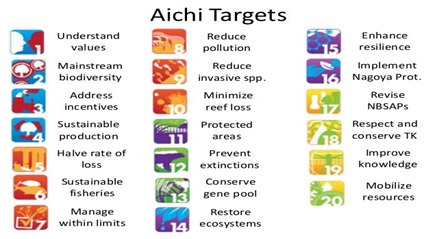
- The Aichi Targets, adopted during the 2010 CBD summit in Nagoya, located in Japan’s Aichi prefecture, included goals such as reducing deforestation by at least half during the coming decade and curbing pollution so that it no longer harmed ecosystems.
- according to a September 2020 UN assessment, No single country met all 20 Aichi Targets within its own borders.
- India is also a party to the Convention.
- The convention is legally binding on its signatories.
- Only two member states of the United Nations are not Parties to the CBD, namely: the USA and the Vatican.
- The most notable Aichi objective and one of the few to include a numerical goal — aimed to protect or conserve 17% of all land and inland waters and 10% of the ocean by the end of the decade.
- Today about 15% of the world’s land and 8% of ocean territories are under some form of protection, though the level of protection varies.
- The Global Environment Facility, the primary source of financing for international biodiversity protection, has collected around $5 billion from 29 countries for the funding period from 2022 to 2026.
- The Aichi Targets also failed to garner buy-in from governments beyond the environmental ministers who brokered the deal.
About Global Environment Facility (GEF):
- The Global Environment Facility (GEF) is a multilateral environmental fund that provides grants and blended finance in developing countries for projects related to:
- biodiversity and climate change,
- international waters,
- land degradation,
- persistent organic pollutants (POPs),
- mercury,
- sustainable forest management,
- food security, and
- sustainable cities.
- It is the largest source of multilateral funding for biodiversity globally.
- It was established ahead of the 1992 Rio Earth Summit.
- In addition to funding projects, the GEF also serves as financial mechanism for the following conventions:
- Convention on Biological Diversity (CBD)
- United Nations Framework Convention on Climate Change (UNFCCC)
- United Nations Convention to Combat Desertification (UNCCD)
- Stockholm Convention on Persistent Organic Pollutants
- Minamata Convention on Mercury
- It also supports implementation of the Montreal Protocol on Substances that Deplete the Ozone Layer.
Source: Indian Express
Previous Year Question
Q.1) With reference to ‘Global Environment Facility’, which of the following statements is/are correct? (2014)
- It serves as financial mechanism for ‘Convention on Biological Diversity’ and ‘United Nations Framework Convention on Climate Change’
- It undertakes scientific research on environmental issues at global level
- It is an agency under OECD to facilitate the transfer of technology and funds to underdeveloped countries with specific aim to protect their environment
- Both (a) and (b)
Q.2) With reference to an initiative called ‘The Economics of Ecosystems and Biodiversity (TEEB)’, which of the following statements is/are correct? (2016)
- It is an initiative hosted by UNEP, IMF and World Economic Forum
- It is a global initiative that focuses on drawing attention to the economic benefits of biodiversity
- It presents an approach that can help decision-makers recognize, demonstrate and capture the value of ecosystems and biodiversity
Select the correct answer using the code given below.
- 1 and 2 only
- 3 only
- 2 and 3 only
- 1, 2 and 3
Open in new window
Syllabus
- Prelims – Environment
Context: Recently, the Rajya Sabha passed the Wild Life (Protection) Amendment Bill, 2022 which seeks to give effect to India’s obligations under the Convention on International Trade on Endangered Species of Wild Fauna and Flora (‘CITES’).
About Wild Life (Protection) Act, 1972:
- The Wild Life (Protection) Act, 1972 provides a legal framework for the protection of various species of wild animals and plants, management of their habitats, regulation and control of trade in wild animals, plants and products made from them.
- The act also lists schedules of plants and animals that are afforded various degrees of protection and monitoring by the government.
Proposed Amendments in the Bill:
- This amendment proposed a new schedule for species listed in the Appendices under CITES.
- Section 6 has been amended to constitute Standing Committee to exercise such powers and duties as may be delegated to it by the State Board for Wildlife.
- Section 43 of the act amended which permitted the use of elephants for ‘religious or any other purposes’.
- To enable the Central government to appoint a Management Authority Section 49E has been inserted.
- The Bill also enhances the penalties prescribed for violation of provisions of the Act.
- For ‘General violations’, maximum fine is increased from 25,000 to 1 lakh.
- In case of Specially protected animals, the minimum fine of Rs. 10,000 has been enhanced to Rs. 25,000.
- To allow the Central Government to appoint a Scientific Authority to provide guidance on matters relating to the impact on the survival of the specimens on being traded.
- The Bill also empowers Central government to regulate and stop the import, trade or possession of invasive plant or animal alien species.
Concerns Associated with the Bill:
- Phrase “any other purpose” is vague and has potential of encouraging commercial trade of elephants.
- Some important issues regarding Human-Wildlife conflict, Eco-sensitive zone rule, etc., has not been addressed.
- According to the report provided by the Parliamentary Standing Committee, species listed in all three schedules of the Bill are incomplete.
- The scientists, botanists, biologists are short in number and needed greater inclusion of them to accelerate the process of listing all existing species of wildlife.
Regulations regarding Elephants Translocation:
- The Forest Act enacted in 1927 listed elephants as Cattle, whereas WLPA, 1972 considers elephants, donkeys, mules, camels, and horses as “vehicles”.
- Though the elephant is being given the highest legal protection in 1977, the elephant is the only animal in the Wildlife Protection Act Schedule-1 which could be legally owned by means of inheritance or gift.
- One among the several amendments in WLPA, 1972 prohibits trade in captive wildlife and any transfer across state boundaries without the permission of respective chief wildlife warden which made elephant trade underground as elephant traders fixed fake commercial deeds to present elephants as gifts for inter-state transfer.
- The WLPA amendment Bill 2021 proposed an exception to Section 43: “This section shall not apply to the transfer or transport of any live elephant by a person having a certificate of ownership, where such person has obtained prior permission from the State Government on fulfilment of such conditions as may be prescribed by the Central Government.”
Conflict of Vermin:
- The damage to the national economy due to crop depredation by wild animals has never been computed. Since 1972, the WLPA has identified a few species — fruit bats, common crows, and rats — as vermin.
- Killing animals outside this list was allowed under two circumstances: *Under Section 62 of WLPA, given sufficient reasons, any species other than those accorded the highest legal protection (such as tigers and elephants but not wild boars or nilgais) can be declared vermin at a certain place for a certain time.
- Under Section 62 of WLPA, given sufficient reasons, any species other than those accorded the highest legal protection (such as tigers and elephants but not wild boars or nilgais) can be declared vermin at a certain place for a certain time.
- Under Section 11 of WLPA, the chief wildlife warden of a state can allow the killing of an animal, irrespective of its status in the Schedules, if it becomes “dangerous to human life”.
- In recent years, however, the Centre has started using its powers under Section 62 to issue sweeping orders declaring species as vermin at even state levels, often without any credible scientific assessment.
- For example, nilgais were declared as vermin across 20 districts in Bihar for a year in 2015.
- The Centre cited “large-scale destruction of agriculture” as the ground for declaring monkeys (Rhesus macaque) vermin in Shimla municipality in 2019.
- The issue has since entered the realm of centre-state politics. Since last year, Kerala’s requests for declaring wild boars as vermin have been turned down repeatedly by the Environment ministry.
MUST READ: CITES
Source: Indian Express
Previous Year Question
Q.1) With reference to Indian laws about wildlife protection, consider the following statements :
- Wild animals are the sole property of the government.
- When a wild animal is declared protected, such animal is entitled for equal protection whether it is found in protected areas or outside.
- Apprehension of a protected wild animal becoming a danger to human life is sufficient ground for its capture or killing.
Which of the statements given above is/are correct? (2022)
- 1 and 2
- 2 only
- 1 and 3
- 3 only
Q.2) If a particular plant species is placed under Schedule VI of The Wildlife Protection Act,1972, what is the implication? (2020)
- A licence is required to cultivate that plant
- Such a plant cannot be cultivated under any circumstances
- It is a Genetically Modified crop plant
- Such a plant is invasive and harmful to the ecosystem
Open in new window
Syllabus
- Prelims – Environment
In news: Three medicinal plant species found in the Himalayas have made it to IUCN Red List of Threatened Species following a recent assessment.
- The Himalayas are a rich repository of medicinal plants whose number in the region stands at 1,748.
Meizotropis pellita:
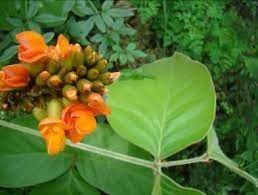
- Meizotropis pellita = ‘Critically endangered’ – based on its limited area of occupancy (less than 10 sq. km)
- Meizotropis pellita, commonly known as Patwa, is a perennial shrub that is endemic to Uttarakhand.
- Threats – deforestation, habitat fragmentation and forest fires.
- Uses – The essential oil extracted from the leaves of the species possesses strong antioxidants and can be a promising natural substitute for synthetic antioxidants in pharmaceutical industries
Fritillaria cirrhosa:
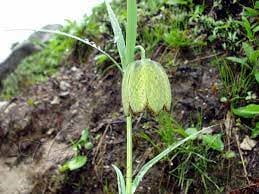
- Fritilloria cirrhosa = ‘Vulnerable’
- Fritillaria cirrhosa (Himalayan fritillary) is a perennial bulbous herb
- Threats – long generation length, poor germination potential, high trade value, extensive harvesting pressure and illegal trade.
- a decline of at least 30% of its population over the assessment period (22 to 26 years)
- In China, the species is used for the treatment of bronchial disorders and pneumonia.
- The plant is also a strong cough suppressant and source of expectorant drugs in traditional Chinese medicine
Dactylorhiza hatagirea:

- Dactylorhiza hatagirea (Salampanja) = ‘Endangered’
- Threats – habitat loss, livestock grazing, deforestation, and climate change.
- Uses – Ayurveda, Siddha, Unani and other alternative systems of medicine to cure dysentery, gastritis, chronic fever, cough and stomach aches. It is a perennial tuberous species endemic to the Hindu Kush and Himalayan ranges of Afghanistan, Bhutan, China, India, Nepal, and Pakistan.
Other Himalayan species:
- Himalayan Trillium govanianum (Himalayan Trillium): Endangered
- Trillium tschonoskii (Keun-yeon-yeong-cho), Endangered .
Source: The Hindu
Previous Year Question
Q.1) Recently, our scientists have discovered a new and distinct species of banana plant which attains a height of about 11 metres and has orange-coloured fruit pulp. In which part of India has it been discovered? (2016)
- Andaman Islands
- Anaimalai Forests
- Maikala Hills
- Tropical rain forests of northeast
Open in new window
Syllabus
- Prelims – Geography
In news: Oil companies are threatening two of Africa’s most iconic biodiversity hotspots in an effort to drill for oil that will ultimately make its way to a global elite and won’t benefit Africans, a recent report by a German non-profit has highlighted.
- The impact of the oil exploration projects being pursued in both locations could ring the death-knell for wildlife and render communities living there homeless.
- ReconAfrica, a Canadian company, has been drilling for oil in the Kavango Zambezi Transfrontier Nature Conservation Area (KAZA).
Okavango delta:
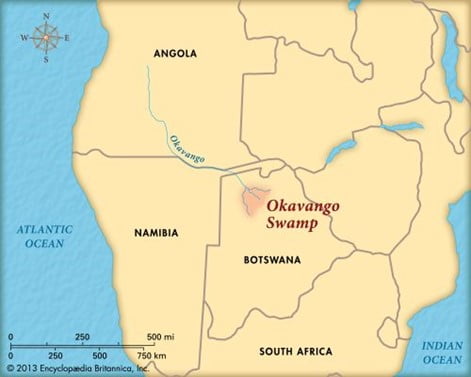
- The Okavango delta is a UNESCO World Heritage Site
- It is in southern Africa.
- It is homeland of indigenous people like the San.
- It is formed by the Okavango river – originates in the highlands of Angola.
- The river flows into the Kalahari desert of southern Africa and spreads out, forming what is called a ‘fan’.
- It is one of the very few major interior delta systems that do not flow into a sea.
- This delta comprises permanent marshlands and seasonally flooded plains.
Importance of Okavango delta:
- The Okavango’s waters make the otherwise dry area a waterlogged wetland that provides vital water resources for animals, plants and over one million people.
- It is home to Africa’s Big Five wildlife species: Savanna elephants, Cape buffaloes, rhinos, lions and leopards.
- There are also giraffes, zebras, antelopes, pangolins, 400 bird species and over 1,000 plant species.
- More than 200,000 people live in the area that falls under ReconAfrica’s exploration licenses.
Threats to Okavango delta:
- oil spill could pollute the Okavango River and the Okavango delta.
- noise, infrastructure construction, toxic chemicals
Murchison Falls:
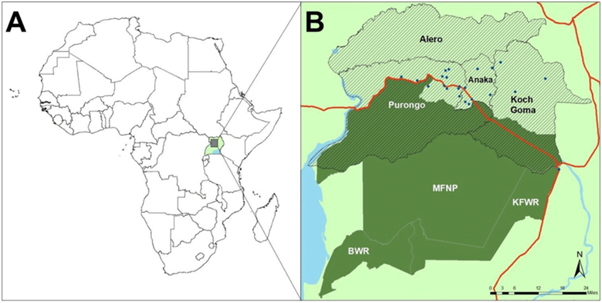
- It is Uganda’s oldest and largest national park,
- It is home to iconic African wildlife species.
- It is situated on the northern shore of Lake Albert, one of the Rift Valley Great Lakes that lies on the border between Uganda and the Democratic Republic of the Congo.
- The Victoria Nile flows through the park and elephants, hippos, Nile crocodiles, buffaloes and marabou storks can regularly be seen on its banks.
- It harbours 556 bird species and 188 mammal species
Kavango Zambezi Transfrontier Nature Conservation Area (KAZA):
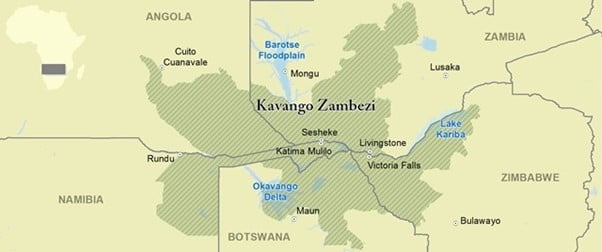
- KAZA is the second-largest nature and landscape conservation area in the world.
- It is spread across the borders of Angola, Botswana, Namibia, Zambia and Zimbabwe.
About Botswana:
- Capital – Gaborone
- It is a landlocked country in Southern Africa.
- Its 70% territory is covered by Kalahari Desert.
- Botswana has the world’s largest elephant population, estimated to be around 130,000.
- It is Africa’s oldest continuous democracy.
Source: DTE
Previous Year Questions
Q.1) Consider the following pairs: (2018)
Regions sometimes Country
mentioned in news
- Catalonia — Spain
- Crimea — Hungary
- Mindanao — Philippines
- Oromia — Nigeria
Which of the pairs given above are correctly matched?
- 1, 2 and 3
- 3 and 4 only
- 1 and 3 only
- 2 and 4 only
Open in new window
Syllabus
- Prelims – Current affairs
In News: A division Bench of the Kerala High Court said that the stipulation of the period of one year or more for filing a divorce petition by mutual consent — under Section 10 A of the Divorce Act, 1869 — violates fundamental rights and is unconstitutional.
- The couple moved the High Court under Section 151 of the Code of Civil Procedure.
- The couple also filed another petition to declare that the waiting period of one year fixed under Section 10A (1) of the Act is unconstitutional.
- The right to a judicial remedy if curtailed by statutory provisions, the court will have to strike it down as it is violative of a fundamental right.
Divorce Act 1869:
- It is the only codified law governing personal laws of Christian community.
- It contains provisions for dissolution of marriages, nullity decrees, custody issues, restitution of conjugal rights etc.
- Section 10 contains grounds on which a court may dissolve a marriage.
- Section 10-A, parties may together mutually file a petition for divorce in the District Court.
- They must have lived separately for two years and must be unable to live together.
Source: indianexpress
Open in new window
Syllabus
- Prelims – Current Affairs
In News: The 17th Asia and the Pacific Regional Meeting of the International Labour Organisation (APRM of ILO) set ten-point priorities of national action for the member countries to deal with the issue of dwindling wages of workers, inflation and unemployment.
Singapore Declaration:
- Adopted by ILO in Singapore by governments representatives, employers and workers in the regions.
- Social dialogue is essential to address labour market challenges and finding solutions in crisis situations such as the COVID-19 pandemic, natural disasters, and economic uncertainty.
- It is key to building trust, and resilient labour market institutions are essential to sustained recovery and inclusive and sustainable growth, and need to be strengthened in the regions.
- It can be achieved through promotion of freedom of association and the effective recognition of the right to collective bargaining throughout the regions, including for workers in vulnerable situations and workers in the informal economy, as enabling rights for decent work.
- It also called for closing gender gaps, increasing women’s labour force participation, promote equal pay for work of equal value, balance work and responsibilities, and promoting women’s leadership.
- A smooth and sustained transition from the informal to formal economy, guided by the Transition from the Informal to the Formal Economy Recommendation, 2015 (No. 204 of the ILO recommendations).
Source The Hindu
Open in new window
Syllabus
- Mains – GS 2 (Governance)
Context: The government has approved the implementation of the Ken-Betwa Link Project (KBLP), one of the links under the Peninsular Rivers Component, in December 2021 with an estimated cost of ₹44,605 crores with central support of ₹39,317 crores through a special purpose vehicle – Ken Betwa Link Project Authority.
About Interlinking of Projects:
- The National River Linking Project (NRLP) formally known as the National Perspective Plan, envisages the transfer of water from water surplus basins where there is flooding to water-deficit basins where there is drought and scarcity, through inter-basin water transfer projects.
- The project is being managed by India’s National Water Development Agency (NWDA), under its Ministry of Jal Shakti.
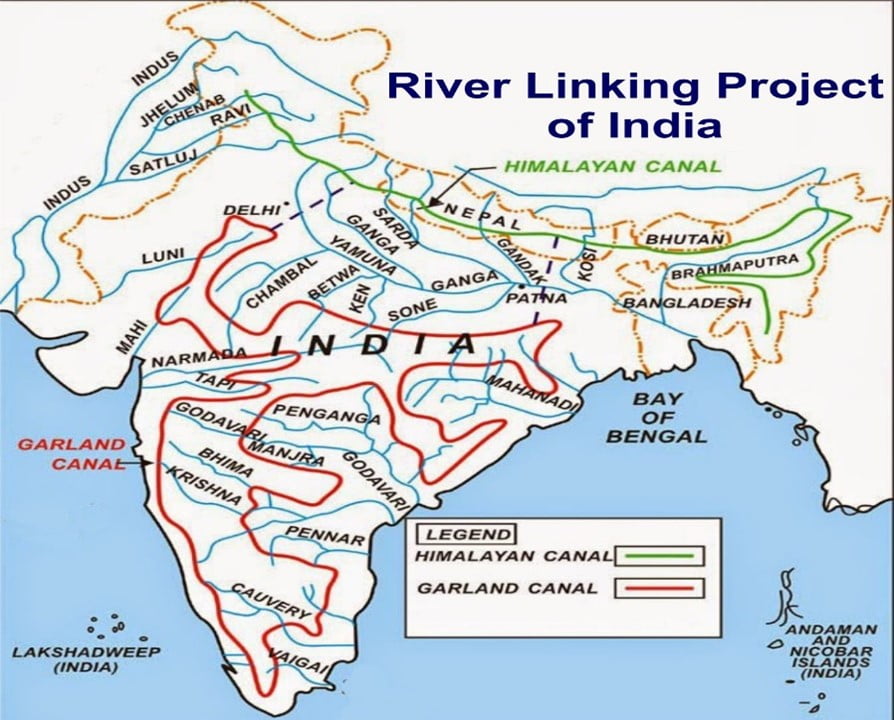
The two components of the project are:
Himalayan Component has 14 projects in the pipeline:
- Storage dams to be constructed on the rivers Ganga and Brahmaputra and their tributaries.
- Linking of ganga and Yamuna
- Connecting Brahmaputra and ganga basins to the Mahanadi basin.
- Connecting eastern tributaries of the Ganga with the Sabarmati and Chambal river systems.
Peninsular Component projects linking of 16 rivers in southern India:
- Surplus water from Mahanadi and Godavari will be transferred to Krishna, Kaveri, Pennar, and Vaigai rivers.
- Linking Mahanadi and Godavari river basins to Kaveri, Krishna, and Vaigai river systems.
- Ken to Betwa river, and Parbati and Kalisindh rivers to Chambal river.
- West flowing rivers to the south of Tapi to the north of Mumba.
Benefits of National river linking project (NRLP):
- Water crisis: The project envisages resolving the water shortage issues by diverting excess water from plains to deficit regions.
- Hydropower generation: The building of dams and reservoirs can generate about 34000 MW of electricity from this project.
- Weather flow augmentation: In dry weather, surplus water stored in reservoirs can be released to rivers to maintain minimum water flow in rivers.
- Agriculture: The Farming sector in India is very much monsoon-dependent, hence the project aims to solve the lack of irrigation facilities in water deficit regions.
- Inland waterways: The transport and connectivity through inland waterways will benefit commercially.
- Reduce dependence on Monsoon: As Indian agriculture is ‘Gambling with monsoons’, the major benefit will be taken by the farmers who need not depend on the untimely rains for agricultural processes.
The overall implementation of the Interlinking of Rivers program under the National Perspective Plan would give benefits of 35 million hectares of irrigation, raising the ultimate irrigation potential from 140 million hectares to 175 million hectares and generation of 34000 megawatts of hydropower, apart from the incidental benefits of flood control, navigation, water supply, fisheries, salinity and pollution control, etc.
Challenges arising out of Interlinking of Rivers:
- Deforestation: Creation of canals would need large areas of land resulting in large-scale deforestation in certain areas.
- Topography: For the interlinking of the rivers, canals will be built, and that will change the topography of the region.
- Areas getting submerged: Possibility of new dams comes with the threat of large otherwise habitable or reserved land getting submerged under water or surface water.
- For instance, the Ken-Betwa River Interlinking (KBRIL) Project will lead to the submergence of a major portion of the core area of the Panna Tiger Reserve in Madhya Pradesh.
- Aqua life: Several leading environmentalists are of the opinion that the project could be an ecological disaster.
- There would be a decrease in downstream flows resulting in a reduction of freshwater inflows into the seas seriously jeopardizing aquatic life.
- Displacement of people: As large strips of land might have to be converted to canals, a considerable population living in these areas must need to be rehabilitated to new areas.
- International issues: There is a lack of an international legal framework for the projects India is proposing.
- In at least some inter-link projects, neighbouring countries such as Bangladesh may be affected, and international concerns for the project must be negotiated.
- Inter-state disputes: River water has no boundary and flows across different states. Hence River water remains a matter of dispute between the states normally.
- Interlinking of those already disputed rivers can further worsen the situation between the states.
- Dirtying of clean water: As the rivers interlink, rivers with dirty water will get connected to rivers with clean water, hence dirtying the clean water.
Way Forward:
The interlinking of rivers project is a major challenge and an opportunity to deal with water-related problems such as drought, floods, climate change, and so on. The long-term strategy for the water deficit problem lies in making the interlinking of rivers challenging by building a network of dams, reservoirs, barrages, hydropower structures, and canals throughout the geographical regions of the country.
However, the interlinking of rivers is a good solution for the shortage of water, but interlinking has to take place after a survey and detailed study to overcome the possible challenges in its implementation.
About National Water Development Agency:
- It was set up in July 1982 as an autonomous society under the Societies Registration act 1860 under the Ministry of Jal Shakti.
- It was established to carry out the water balance and other studies on a scientific and realistic basis for optimum utilization of water resources of the Peninsular River system for preparation of feasibility reports and thus to give concrete shape to the Peninsular River development component of the National perspective plan.
- NWDA explores the feasibility of intra-states links and takes up the work for the preparation of a Detailed Project Report (DPR) of river link proposals under the National Perspective Plan (NPP) and DPRs of intra-State links.
Source: The Hindu
Open in new window
Syllabus
- Mains – GS 2 (Governance) and GS 4 (Ethics, Integrity and Aptitude)
Context: Recently the International Anti-Corruption Day-2022 was organised by the CBI on ‘Anti-Corruption efforts – A sine qua non for Development and Security.
About the Corruption:
- Corruption refers to misusing public power for personal gain. It can be done by an elected politician, civil servant, journalist, administrator of a school, or anyone in authority.
- Apart from public corruption, we also have private corruption between individuals and businesses.
- Thus, the corruption definition applies to different forms.
Global surveys and indices:
- India has the highest rate of bribery and use of personal links to access public services such as healthcare and education in Asia, according to a survey released by global civil society Transparency International.
- India is in the 85th position among 180 countries in the Corruption Perception Index, 2021.
Causes of corruption:
- Legacy issues: Rampant poverty and empty coffers of the government at the dawn of independence leading to chronic low salaries of the government officials
- Pre liberalization license permit raj catered by Monopolies and restrictive trade practices facilitated the corruption.
- The lack of economic freedom led to abuse of the system.
- Necessities of development overshadowed vigilance procedures.
- Political system: Use of black money in elections to win at any cost creates the need for the recovery of that cost through malpractices.
- Election funding is not transparent making it prone to the usage of black money and funding based on quid pro quo.
- It leads to crony capitalism, an unholy nexus between politicians and corporates.
- Criminalization of politics- when the rule-breakers become rule makers, the casualty is the rule of law.
- Economic structure: Low levels of formalization (merely 10%) of the economy breed black money.
- Stringent compliance rules for entry and exit for businesses result in bribery.
- Unequal distribution of wealth – Transparency International data suggests that corruption is directly proportionate to the economic gap in a nation.
- Legal lacunae: Archaic laws like IPC 1860 don’t capture the complexities of administration and lead to the escape of wrongdoers.
- Lacunae in the Lokpal act and delays in the appointments both at the state and central levels
- Dilution of the RTI act and political misuse of CBI and other agencies.
- Administrative lacunae: Loopholes give discretionary powers to the officials making working prone to corruption.
- Lack of resources, funding, infrastructure and manpower in the vigilance institutions.
- Lack of incorporation of standard practices by organizations like Banks, sports organizations which results in multi-billion-rupee scams.
- g. Punjab National Bank scam, commonwealth scam.
- Judicial delays: Lack of protection to good Samaritans
- Targeting of upright and non-corrupt officials and rewards to corrupt officials
- Near non-existent whistleblowers protection
- Social problems: The mindset of the citizenry that doesn’t look at the problems seriously and even accepts it as a necessary part of the system.
- Increasing consumerism in the new middle class that is ready to bribe to get things done.
- Failure of social morality, education system to inculcate the values
Impacts of corruption:
- Hindrances to developmental process: Loss of wealth due to corruption and siphoning away of taxpayers’ money leave little to spend in the social sector.
- Corruption in the social sectors like PDS, health and education schemes lead to demographic disadvantage.
- Economic loss: Undermines ease of doing business.
- Corruption in the public services sector carries high risks for conducting good businesses.
- Companies are likely to unwanted red tapes, petty corruption, bribes for finalizing any procedures or deals.
- Wrong allocation policies result in undervaluation of resources like Coal blocks, Hydrocarbon projects, Spectrum allocation. Eg. 2G scam, Coalgate.
- This mismanagement of resources leads to environmental degradation and exploitation.
- Corruption of financial sector officials like Banks, the stock market erodes the strength of the economy. E.g. PNB scam, PMC scam, Harshad Mehta scandal
- Social sector losses: Corruption in government projects targeting poor and vulnerable section of the society increases the economic gap between the rich and the poor
- The corrupt system denies the poor a chance to improve their status rendering them eternally poor
Legal Framework for Fighting Corruption:
- Prevention of Corruption Act, 1988 provides for penalties in relation to corruption by public servants and also for those who are involved in the abetment of an act of corruption.
- Amendment of 2018 criminalised both bribe-taking by public servants as well as bribe giving by any person.
- The Prevention of Money Laundering Act, 2002 aims to prevent instances of money laundering and prohibits use of the ‘proceeds of crime’ in India.
- The Companies Act, 2013 provides for corporate governance and prevention of corruption and fraud in the corporate sector.
- The term ‘fraud’ has been given a broad definition and is a criminal offence under the Companies Act.
- The Indian Penal Code, 1860 sets out provisions which can be interpreted to cover bribery and fraud matters, including offences relating to criminal breach of trust and cheating.
- The Foreign Contribution (Regulation) Act, 2010 regulates the acceptance and use of foreign contributions and hospitality by individuals and corporations.
Regulatory Framework:
- The Lokpal and Lokayuktas Act, 2013 provides for an establishment of an ombudsman for the central and state governments (Lokpal and Lokayuktas, respectively).
- These bodies are required to act independently from the government and have been empowered to investigate allegations of corruption against public servants, which include the prime minister and other ministers.
- The Central Vigilance Commission is mandate is to oversee the vigilance administration and to advise and assist the executive in matters relating to corruption.
Suggestive Measures:
- Education: Education is one of the most critical steps. It can help in reinforcing the correct business practices.
- Mandatory education courses like anti-money laundering must be introduced.
- Accountability: Accountability mechanisms can also help in curbing corruption.
- Efficient Reporting: Furthermore, it can be easier to reduce corruption if reporting it becomes simple.
- Leading by the best practices: The senior employees in the management department must lead by example and cultivate an open and transparent culture.
- Encouraging ethical culture: Similarly, rewards and incentives must be granted to encourage people to cultivate an ethical culture.
- Need for innovative anti-corruption solutions: There is the need for real-time information sharing between law enforcement agencies.
There is a need for windfall reforms in each and every section of the system to fight the menace. Every aspect of governance must be improved for efficiency, economy, and effectiveness.
About International Anti-Corruption Day (IACD):
- It has been observed annually, on 9 December, since the passage of the United Nations Convention Against Corruption on 31 October 2003
Significance of 2022 IACD:
- The 2022 IACD also marks the beginning of the twentieth anniversary of the UN Convention Against Corruption – UNCAC.
- This is reflected by the theme of this year’s international day, ‘UNCAC at 20: Uniting the World Against Corruption.’
- It seeks to highlight the crucial link between anti-corruption and peace, security, and development.
Source: Indian Express
Open in new window
Syllabus
- Mains – GS 3 Indian Economy
In News: During his recent United Nations General Assembly speech, external affairs minister S. Jaishankar told the world about India’s ambition to become a developed country by 2047, a century after the country’s independence.
Context:
- In his Independence Day address, Prime Minister Narendra Modi asked Indians to embrace the “Panch Pran” — five vows — first vow being a developed country.
- India’s growth prospects and the zeal of its citizens and policymakers alike, it has a realistic chance of meeting these goals over 25 years.
- But before embarking on this journey, there is a need for sincere reflection and identification of the strategies needed to take us there.
Meaning of a developed country:
- The ‘World Economic Situation and Prospects’ of the United Nations classifies countries into three broad categories: developed economies, economies in transition, and developing economies – to reflect basic economic country conditions.
- The World Trade Organization (WTO) has no technical classification for a country’s stage of economic development. It expects countries to define themselves as developed or developing.
- Former US President Donald Trump had criticised the categorisation of China as a “developing” country, which allowed it to enjoy some benefits in the World Trade Organization.
- Usual criteria include – size of their GDP, presence of high-quality infrastructure such as Singapore.
- For example, membership of the Organization for Economic Co-operation and Development’s (OECD) countries comprising 30 member states, is considered to be the marker of being among the world’s most developed.
Considerations for Development:
- World’s largest multinational corporations taking advantage of global movement of capital.
- In the era of international outsourcing, gross national income becomes more relevant for companies headquartered in these countries, as their global operations allow them to earn multiple income streams, irrespective of the actual location of production
- Net exporters of high technology, high value goods and services.
- This helps most of them run a current account surplus and invest in research, improving their factor productivity and profits.
- Large multinational banks:
- These are instrumental in reducing the overall cost of capital.
- This in turn leads to high standards of living, as households can enjoy credit-powered consumption.
- Governments and firms can also raise cheap debt for capital expenditure and fashionable restructuring exercises.
- Powerful currencies and therefore powerful central banks at the helm.
- Their respective currencies contribute to a bulk of international currency trading and are used as ‘valuer currencies’ in international commodity trading.
- This feature makes their central banks influential money magnets, controlling global capital flows through interest rate modulations.
- Active citizen groups that help organize their economies.
- This means that the ‘rights to responsibility’ ratio is stacked such that citizens take pride in giving precedence to ‘responsibility’ while building their nations.
- For instance, Greta Thunberg of Sweden, a climate-rights activist.
- Successful eradication of absolute poverty and provide some form of minimum living standard to their citizens.
- Safety nets in terms of basic healthcare, minimum state-sponsored education and unemployment benefits are universally available.
- The direction of public policy is typically set through democratic processes at all levels.
India’s story:
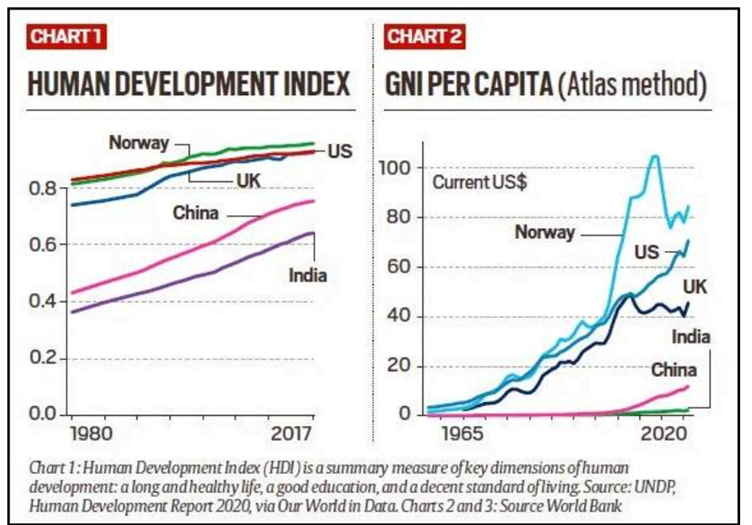
- Income-based: India is the third largest economy in the world in Purchasing Power Parity (PPP) terms.
- However, on per capita income, India is behind even Bangladesh.
- China’s per capita income is 5.5 times that of India, and the UK’s is almost 33 times.
- HDI Metrics: India’s rank is 132 out of 191 countries.
- We have made secular improvement on HDI metrics. For instance, the life expectancy at birth (one of the sub-metrics of HDI) in India has gone from around 40 years in 1947 to around 70 years.
- However, India has still not completely eradicated hunger, poverty, illiteracy and unemployment.
- Nature of economy: Like many developed nations, it’s already a services-led economy, with its IT companies serving blue-chip clients across the globe, in the US, EU and beyond.
- Such as, China’s agrarian economy too made way for manufacturing, becoming the world’s factory, harnessing its low labour costs, skilled workforce and good infrastructure. Bangladesh is now attempting something similar.
- Institutes of higher learning: India, like developed nations, has IITs to IIMs.
- Their alumni have run some of the world’s most influential corporations —from Google and Pepsi to IBM and Twitter.
- However, they still lag behind in QS world ranking such as IISc Bangalore at number 52nd and are not in the league of MIT, Harvard and Stanford yet
- Evolved equity markets
- India was among the first few countries in the world to adopt the T+1 settlement cycle, making it one of the most transparent equity markets in the world.
- We have both a liquid cash and derivatives market and has rewarded investors, including foreign portfolio investors, handsomely.
Suggestions for future:
- Increase consumption: A 2018 diagnostic report on India by the World Bank said – 10% of Indians, at most, have consumption levels above the commonly used threshold of $10 (PPP) per day expenditures for the global middle class.
- Increase in per capita income: World Bank updated the per capita income criteria for high-income countries to more than $13,205, while India’s GDP per capita is currently around $2,200.
- Increase in HDI: India’s current HDI score (0.64) is much lower than what any of the developed countries had even in 1980.
- China reached the 0.64 level in 2004, and took another 13 year to reach the 0.75 level — that, incidentally, is the level at which the UK was in 1980.
- Eradication of poverty: Only when poverty is largely addressed can the social development levels, including medical care, health and literacy, be improved.
- For example, China started a targeted poverty alleviation campaign, bringing 10 to 14 million people per year out of poverty since 2013 and declared complete victory in eradicating absolute poverty recently.
- Leveraging the demographic dividend and attempt to achieve full employment:
- India is estimated to become the world’s most populous country in 2023, overtaking China, according to UN figures.
- China’s median age is 37.1 while India is 27.6 years old.
- Creation of a global middle class: Households have access to better education and health care, clean water, improved sanitation, reliable electricity, a safe environment, affordable housing, and enough discretionary income to spend on leisure pursuits.
- Tackling social and other evils : caste system, land system, labour laws, etc, have long been hamstringing India
Way forward:
- India has made rapid strides over the decades, particularly after the watershed 1991 reforms, but still has a long way to go on basic human development and socio-economic indicators.
- The OECD nations, by virtue of being wealthy, must make their resources available for the economic development of the rest of the world.
Baba’s Explainer – National Judicial Appointments Commission (NJAC)
Syllabus
- GS-2: Structure, organization and functioning of the Judiciary.
- GS-2: Government policies and interventions for development in various sectors and issues arising out of their design and implementation.
Context: Vice-President entered the heated debate between the Central government and the Supreme Court over the matter of judicial appointments.
- In 2015, Supreme Court struck down the National Judicial Appointments Commission (NJAC) and the 99th Amendment, which the executive considers it as “the will of people”.
- The seven-year-old verdict has been invoked by both sides-
- Supreme Court has asked if the government’s “unhappiness” over the failure of the NJAC was why it was sitting on the names recommended by the Supreme Court Collegium.
- On the other hand, Law Minister has commented on public fora about how the NJAC could have provided a transparent alternative to the decades-old Collegium system of appointing judges.
Read Complete Details on National Judicial Appointments Commission (NJAC)
Practice MCQs
Q.1) The term “KAZA” often heard in the news roughly corresponds to which of the following regions ?
- Region along the border of Gaza strip near the Mediterranean shores
- Region along southern Africa stretching from Angola to Zimbabwe
- Region along Persian Gulf and Horn of Africa
- The entire coastal areas of the Mediterranean Sea.
Q.2) With reference to “Patwa” sometimes mentioned in the news, consider the following statements:
- It is a medicinal shrub.
- It grows in the Western Ghats.
- It is a strong anti-oxidant that can be used in pharmaceutical industries.
Which of the statements given above is/are
- 1 only
- 3 only
- 1 and 3
- 2 and 3
Q.3) With reference to ‘Global Environment Facility’, which of the following statements is/are correct?
- The Global Environment Facility (GEF) is a multilateral environmental fund that provides grants and blended finance in developing countries for projects related to biodiversity.
- It was established ahead of the 1972 Rio Earth Summit.
- It also supports implementation of the Montreal Protocol on Substances that Deplete the Ozone Layer.
Select the correct answer by using the code given below:
- 1 and 3 only
- 2 and 3 only
- 1 and 2 only
- 1 2 and 3
Comment the answers to the above questions in the comment section below!!
ANSWERS FOR ’ 12th December 2022 – Daily Practice MCQs’ will be updated along with tomorrow’s Daily Current Affairs.st
ANSWERS FOR 10th December – Daily Practice MCQs
Q.1) – a
Q.2) – d
Q.3) – c














